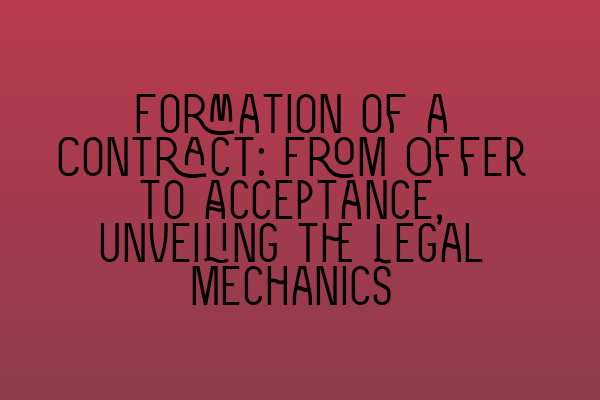Formation of a Contract: From Offer to Acceptance, Unveiling the Legal Mechanics
Introduction
In the world of contract law, the process of forming a legally binding agreement is a pivotal moment. From the initial offer to the final acceptance, the journey is paved with legal mechanics that ensure the validity and enforceability of the contract. This blog post will explore this journey, shedding light on each step involved and the significance it holds in the eyes of the law.
1. Offer: The Foundation of a Contract
The formation of a contract begins with an offer. An offer is a clear and definitive statement made by one party (the offeror) to another (the offeree), indicating an intent to enter into a contract. It must be communicated with the intention of creating legal relations and must be sufficiently certain and complete. The offer sets the terms and conditions under which the contract will operate.
2. Acceptance: The Final Piece of the Puzzle
Once an offer has been made, the offeree has the option to accept it, forming a binding contract. Acceptance is a manifestation of the offeree’s intention to be bound by the terms of the offer. It must be clear, unconditional, and communicated to the offeror. If the acceptance varies from the terms of the offer, it is considered a counter-offer and does not result in a binding contract.
3. Invitation to Treat: The Potential Precursor
In certain situations, a party may make an invitation to treat instead of an offer. An invitation to treat invites others to make an offer. It is not an offer itself but rather an invitation for negotiation. Examples of invitations to treat include advertisements, price lists, and auctions. It is important to distinguish between an invitation to treat and an actual offer to avoid confusion and potential legal disputes.
4. Consideration: The Backbone of a Contract
Consideration refers to something of value that is exchanged between the parties involved in a contract. It is a vital element in contract formation as it demonstrates that each party has given something in return for the promise of the other. Consideration can be in the form of money, goods, services, or even a promise to act (i.e., a promise to do something or refrain from doing something). Without consideration, a contract may lack the necessary legal effect.
5. Intention to Create Legal Relations: Binding Intent
For a contract to be valid, there must be an intention to create legal relations between the parties involved. This means that both parties must demonstrate a serious intent to be bound by the terms of the contract. In commercial transactions, the presumption is that the parties have such an intention, while in domestic and social agreements, the presumption is often the opposite. It is crucial to assess the intent of the parties to determine the enforceability of a contract.
Conclusion
The journey from offer to acceptance is filled with legal mechanics that ensure the formation of a valid and enforceable contract. From the foundation of an offer to the final piece of acceptance, each step holds significance and must be carefully navigated. Understanding these steps and their intricacies is essential in the world of contract law.
Remember, if you need further assistance in preparing for the SQE exams or brushing up on your contract law knowledge, be sure to check out our related articles and resources:
– SQE 1 Practice Exam Questions
– SQE 1 Practice Mocks FLK1 FLK2
– SQE 2 Preparation Courses
– SQE 1 Preparation Courses
– SRA SQE Exam Dates
We hope this blog post has shed some light on the formation of a contract and the legal mechanics involved. If you have any further questions or require legal advice, don’t hesitate to reach out to SQE Contract Law. Our team of expert solicitors is here to assist you every step of the way.
